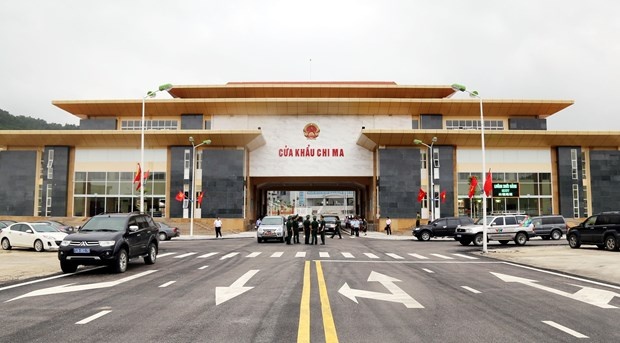Vietnam setting sights on medicinal herb scale-up
 |
| Chi Ma Border Gate in Lang Son province (Photo: VNA) |
Si Ma Cai Himalayan ginseng tea is one of the specialities of Lao Cai province, selling particularly well as consumers have been paying more attention to health issues during the last few years. “We could only supply about 1,000 boxes since July 2020. The harvest from Man Than’s garden, of which than one hectare is used for ginseng, is not enough to produce more tea,” said Vu Thi Nhung, director of the Man Than Cooperative in Si Ma Cai.
Last year, Nhung had to re-evaluate the efficiency of her hollyhock plantation and compare this with her investment. Meanwhile, the imports of sage, one of her raw materials, were increasing, and thyme became scarce.
Nhung, the first woman to begin growing hollyhock in Lao Cai province, decided to expand her plantation for sage in Quan Ho Than commune, from 3,000sq.m to a hectare. She reserved a part of it as a nursery to provide seedlings for farmers in the area and committed another part to sales.
Her bet paid off last year. As the pandemic broke out, the Chinese government ordered suspension of customs clearances at all border gates with Vietnam, causing local businesses to rush to find alternative sources for medicinal herbs. Nhung had never sold so much tea and powdered shiitake before this time.
As trade flows were diverted, more farmers in Lao Cai began to grow medicinal herbs, following the demand of domestic enterprises. The area of medicinal herbs in this province has increased to 2,300ha as of June, an increase of 2.5 times compared to 2016, according to data from the Lao Cai Department of Agriculture and Rural Development (DARD).
The imbalance in the pharmaceutical supply system of Vietnam has led to rising imports of medicinal materials. Vietnam’s demand for medicinal herbs stands at about 60,000 tonnes per year, but the domestic growing areas can only supply about 15,600 tonnes per year. The rest must be imported from abroad, according to Vietnam’s Ministry of Health (MoH).
The demand for medicinal herbs continues to increase following the strong growth momentum of the local pharmaceutical market, the MoH wrote in a report on developing the pharmaceutical industry with domestically produced medicinal herbs towards 2025.
The total value of Vietnam’s pharmaceutical market meanwhile increased from $2.7 billion in 2015 to $3.6 billion in 2018, a compound growth rate of 10.6 per cent. Between these years, the total value of the pharmaceutical industry grew at a compound rate of 10.6 per cent from $600 million to $800 million, creating 7,300 more jobs.
By 2030, Vietnam wants to become a high-value pharmaceutical production centre in the region, with the export value of domestically produced drugs reaching about $1 billion. Previously, domestically produced drugs would reach 75 per cent of the quantity used and 60 per cent of the market value, with the rate of domestic consumption of herbal medicines increasing by at least 10 per cent compared to 2020.
To serve Vietnam’s goal by 2030, the government aims to increase the area for sustainable exploitation of natural, medicinal herbs large-scale production according to the Good Agricultural and Collection Practices of the World Health Organization.
Meanwhile, Lang Son Customs Department is considering setting limits for the import of medicinal herbs through the Chi Ma border gate. “To control the quality up until October 2023, the department will take samples of all imported medicinal herbs for phytosanitary purposes and to identify the origin of the goods,” said the department’s deputy director, Vi Cong Thuong.
In many Vietnamese provinces where medicinal plants are grown, the cultivation method is mainly based on extensive experience, but not yet associated with the market conditions. Many farmers in Dak Nong had to cut down their ginseng and cloves gardens and switch to other industrial crops.
Though importing through the Chi Ma border gate, many pharmaceutical enterprises are becoming increasingly aware of the supply dependence on China, and target to expand the domestic growing area.
Tran Binh Duyen, general director of Vietnam Medicinal Materials JSC, had many working sessions with local leaders on the development of herbal medicine areas according to international standards. Duyen thinks that “expanding the plantations could be a great way to reduce imports from China to below 75 per cent of the present amount.”
Farmers can earn a decent income from growing medicinal plants, about $4,300 per hectare, especially as the value of many types of medicinal herbs can be increased by 10-15 per cent after processing, according to calculations by the Lao Cai’s DARD.
Nhung of the Man Than Cooperative hopes that the situation does not change suddenly. However, “the Si Ma Cai tea production is expected to increase next year, especially when Man Than improves its supply of Himalayan ginseng,” Nhung said.
What the stars mean:
★ Poor ★ ★ Promising ★★★ Good ★★★★ Very good ★★★★★ Exceptional
Related Contents
Latest News
More News
- Businesses ramp up production as year-end orders surge (December 30, 2025 | 10:05)
- Vietjet chairwoman awarded Labour Hero title (December 29, 2025 | 13:06)
- How to unlock ESG value through green innovation (December 29, 2025 | 10:03)
- AI reshapes media and advertising industry (December 29, 2025 | 08:33)
- FPT and GELEX sign deal to develop blockchain tech for global markets (December 29, 2025 | 08:29)
- Vietnam’s GDP forecast to grow by 9 per cent in 2026 (December 29, 2025 | 08:29)
- Women entrepreneurs are key to Vietnam’s economic growth (December 29, 2025 | 08:00)
- Vietnam's top 500 value-creating enterprises announced (December 27, 2025 | 08:00)
- The PAN Group shaping a better future with ESG strategy (December 26, 2025 | 09:00)
- Masan Consumer officially lists on HSX, marking the next phase of value creation (December 25, 2025 | 13:20)

 Tag:
Tag:




















 Mobile Version
Mobile Version